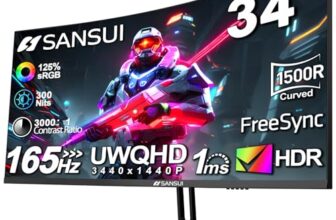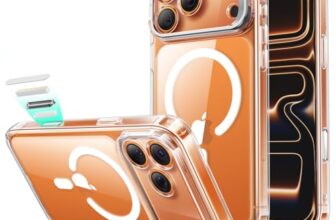TCL S4 Series 4K Roku TV (50S450R) Technical Review: A Masterclass in Accessible Premium Entertainment
Introduction: Redefining the Value Equation in Home Cinema
In the fiercely competitive landscape of home entertainment, the consumer is often faced with a dizzying array of choices and a frustrating series of compromises. The pursuit of a truly cinematic experience—one defined by breathtaking visual fidelity and immersive, three-dimensional sound—has traditionally been a high-cost endeavor, reserved for flagship models with intimidating price tags. This paradigm has created a market where budget-conscious buyers are forced to sacrifice key technologies, settling for a viewing experience that is merely adequate rather than genuinely awe-inspiring. It is this long-standing compromise that the TCL 50-Inch Class S4 4K LED Smart TV with Roku TV (50S450R) not only challenges but decisively obliterates. This is not just another budget 4K television; it is a meticulously engineered entertainment hub that democratizes premium technologies, delivering a suite of high-end features that were, until recently, unthinkable at its price point.
The philosophy behind the TCL S4 series is a masterstroke of integration and user-centric design. It starts with a foundation of excellent picture quality, built upon a 4K Ultra HD panel with a superior Direct LED backlight. But it doesn’t stop there. TCL has integrated a comprehensive and future-proof suite of the most advanced HDR formats, including the gold standard, Dolby Vision, ensuring you see every piece of content exactly as its creator intended. This visual prowess is paired with the immersive, object-based audio of Dolby Atmos, creating a soundscape that envelops the viewer. The entire experience is seamlessly orchestrated by the Roku TV Smart OS, arguably the most intuitive, responsive, and content-rich smart platform on the market. From its gamer-friendly features like Auto Low Latency Mode to its modern, bezel-less design and generous connectivity options, the S4 is a product that consistently over-delivers. This is a television that has garnered a “best seller” status not through marketing hype, but by providing an unparalleled and tangible value proposition.
In this exhaustive, technical review, we will perform a deep dive into the specific technologies that set the TCL S4 apart. We will deconstruct the science behind its HDR PRO performance, analyze the benefits of its Direct LED backlighting system, evaluate the real-world impact of Dolby Atmos, and explore the seamless user experience of the Roku OS. This is a granular analysis for the discerning buyer who wants to understand not just what a TV does, but how and why it does it so well, and to ultimately discover why the TCL S4 is the definitive choice for those seeking premium performance without the premium price.

A Deep Dive into the Key Features: A Technical Dissection of Core Technologies
The TCL S4’s market-leading position is not accidental. It is the result of a strategic and intelligent combination of hardware and software features that deliver a user experience far exceeding its price class. Let’s analyze each of these core components from a technical perspective.
-
4K Ultra HD Resolution: The Foundation of Clarity
The baseline for any modern, high-quality television is its resolution, and the S4 delivers with a full 4K Ultra HD panel. This specification denotes a screen resolution of 3840 x 2160 pixels, which totals over 8.3 million individual pixels. This is precisely four times the pixel count of a 1080p Full HD television (1920 x 1080, ~2.1 million pixels). This exponential increase in pixel density has a profound impact on the viewing experience. It allows the television to render incredibly fine details, textures, and lines with a level of sharpness and realism that is simply impossible on a lower-resolution screen. For a 50-inch screen, this means you can sit closer to the television without the pixel grid becoming visible, creating a more immersive, cinema-like experience. Whether you are watching a native 4K Blu-ray, streaming from a 4K service like Netflix or Disney+, or even viewing upscaled 1080p content, the result is an image that is noticeably crisper, deeper, and more lifelike.

-
HDR PRO: Universal Compatibility with Dolby Vision, HDR10, & HLG
While 4K resolution makes a picture sharper, High Dynamic Range (HDR) makes it better. HDR technology dramatically expands the television’s range of both contrast and color. This allows it to display brighter whites, deeper blacks, and a far wider, more nuanced spectrum of colors in between. The TCL S4’s “HDR PRO” feature is its killer app in this category, denoting its comprehensive support for all the most advanced HDR formats. This is a critical technical advantage. The three key formats are:
- Dolby Vision: This is the premium, gold-standard HDR format. Its key advantage is the use of **dynamic metadata**. This means that color and brightness information is sent to the TV on a scene-by-scene or even frame-by-frame basis, allowing the TV to constantly optimize the picture for the most accurate and impactful presentation. This results in superior detail in both dark and bright scenes.
- HDR10: This is the open, royalty-free standard for HDR. It uses **static metadata**, which means it sets a single average brightness level for the entire movie or show. While still a massive improvement over non-HDR content, it lacks the scene-by-scene refinement of Dolby Vision.
- HLG (Hybrid Log-Gamma): This format was developed primarily for live broadcast television and streaming. It cleverly combines a standard dynamic range signal with an HDR signal in a single stream, ensuring backward compatibility with older TVs.
By supporting all three formats, the TCL S4 guarantees that you will get the absolute best possible HDR picture from any source, whether it’s a 4K Blu-ray with Dolby Vision, a Netflix show in HDR10, or a live sporting event broadcast in HLG. This universal compatibility removes all guesswork and ensures your investment is future-proof.

-
Superior Illumination: The Direct LED Backlight
A critical, yet often overlooked, hardware component is the television’s backlighting system. Many budget TVs use an “edge-lit” system, where LEDs are placed only along the edges of the screen. This can lead to issues with brightness uniformity, such as brighter edges and dimmer centers, or “clouding” in dark scenes. The TCL S4 utilizes a superior Direct LED Backlight. In this configuration, an array of LEDs is placed directly behind the entire surface of the LCD panel. This design allows for a much more even and uniform distribution of light across the screen. The immediate benefit is “better brightness uniformity and picture performance,” eliminating distracting hot spots and ensuring a consistent, high-quality image from corner to corner. This is a key hardware choice that contributes significantly to the S4’s excellent picture quality in its class.
-
Immersive Audio: Dolby Atmos Integration
For decades, home audio has been channel-based (e.g., 5.1, 7.1), where sounds are assigned to specific speakers. Dolby Atmos represents a paradigm shift to object-based audio. In this system, sounds are treated as individual “objects” that can be placed and moved anywhere in a three-dimensional soundscape, including overhead. The TCL S4’s built-in support for Dolby Atmos allows it to decode these complex audio streams. When connected to a Dolby Atmos-compatible soundbar or AV receiver (via the eARC port), it can pass this full, uncompressed audio signal for a truly immersive cinematic experience. Even through its own speakers, the TV’s processing can create a virtualized Atmos effect, providing a sense of height and space that is a noticeable improvement over standard stereo, making movie nights and gaming at home far more engaging.

-
The Brains of the Operation: The Roku TV Smart OS
A television’s smart platform is its soul, and the S4 features one of the best in the business: Roku TV. The Roku OS is renowned for its simplicity, speed, and comprehensive content selection. The interface is a clean, customizable grid of app tiles, making it incredibly easy to navigate for users of all technical skill levels. It provides access to a massive library of streaming services, including all the major players like Netflix, Disney+, Apple TV+, and more. A standout feature is The Roku Channel, which offers a huge selection of free, ad-supported TV shows and hit movies. Roku also provides over 250 free live TV channels, covering news, sports, and entertainment. The universal search function is another powerful tool, allowing you to search for a movie or show and see where it’s available to stream, rent, or buy across all your apps, often highlighting the cheapest or free option first. This fast, intuitive, and content-rich OS makes the S4 an absolute joy to use for all your streaming needs.

-
Gamer-Centric Features: Auto Game Mode (ALLM)
The TCL S4 is an excellent choice for casual and serious gamers alike, thanks to its inclusion of Auto Game Mode (ALLM). ALLM is a feature of the HDMI 2.1 specification that allows the television to automatically detect when a compatible gaming console (like a PlayStation 5 or Xbox Series X/S) is powered on and a game is launched. When detected, the TV instantly switches to its dedicated game mode. This mode bypasses much of the TV’s non-essential video processing to achieve the “lowest possible input lag and latency.” Input lag is the delay between when you press a button on your controller and when you see the corresponding action on the screen. For gaming, especially in fast-paced competitive titles, minimizing this delay is critical. The “auto” part of ALLM means the user doesn’t have to manually dig through menus to enable this mode; it’s a seamless, hands-off experience that ensures you always have an “unmatched gaming performance.”

-
Future-Proof Connectivity: 4 HDMI Inputs with eARC
A television is a hub for all your devices, and the S4 provides generous and powerful connectivity with four high-speed HDMI inputs. This allows you to simultaneously connect a gaming console, a cable/satellite box, a 4K Blu-ray player, and a soundbar without ever needing to swap cables. The crucial feature here is the inclusion of eARC (Enhanced Audio Return Channel) on one of the ports. A standard ARC port can send compressed audio from the TV back to a soundbar. However, eARC has a much higher bandwidth, allowing it to transmit uncompressed, high-resolution audio formats, including the full, object-based signal of Dolby Atmos. This means you can connect all your devices directly to the TV’s other HDMI ports and then run a single HDMI cable from the eARC port to your compatible soundbar or AV receiver, and the TV will pass through the highest possible quality audio from every source. It simplifies your setup and guarantees the best audio performance.

Pros: The Undeniable Technical Strengths
- Comprehensive HDR Support: The inclusion of Dolby Vision, HDR10, and HLG is a premium feature that guarantees the best possible picture quality from any HDR source.
- Superior Backlight Technology: The Direct LED backlight provides excellent screen uniformity and brightness, a clear hardware advantage over edge-lit competitors in its class.
- Immersive Audio Capabilities: Built-in Dolby Atmos decoding, paired with an eARC port, provides a clear pathway to a cinematic, object-based audio experience.
- Best-in-Class Smart OS: The Roku TV platform is exceptionally fast, user-friendly, and packed with a massive selection of content, including extensive free options.
- Excellent for Gaming: Auto Game Mode (ALLM) provides a seamless, low-latency experience for console gamers.
- Generous and Powerful Connectivity: Four HDMI inputs, including one with eARC, offer ample room for all your devices and ensure the highest audio fidelity.
- Elegant and Modern Design: The FullView metal bezel-less design gives the TV a premium look that blends beautifully into any room.
- Exceptional Overall Value: Delivers a suite of technologies and a level of performance typically reserved for much more expensive televisions.

Cons: Important Technical Considerations and Limitations
- 60Hz Native Panel: The “Motion Rate 120” is a motion interpolation technology. The TV’s native panel refresh rate is 60Hz. This means it cannot accept a 4K/120Hz signal from a PS5 or Xbox Series X, a feature reserved for more expensive gaming TVs.
- Lack of Local Dimming: While the Direct LED backlight is great for uniformity, this model lacks full-array local dimming (FALD). This means it cannot dim specific zones of the backlight to produce the deep, inky blacks and high contrast of more advanced TVs.
- Peak Brightness Limitations: As an entry-level model, its peak brightness will be lower than that of premium HDR TVs. This means that while it displays HDR content very well for its class, the most impactful, specular highlights will not be as bright as on a high-end set.
- Internal Speaker Performance: While the TV can decode Dolby Atmos, the built-in speakers can only provide a virtualized approximation of the effect. To experience true, immersive Dolby Atmos, an external soundbar or AV receiver is required.
Conclusion: The Uncontested Champion of Value and Performance
The TCL 50-Inch Class S4 4K LED Smart TV with Roku TV is a truly phenomenal piece of engineering and a masterstroke of product strategy. It succeeds by refusing to make the compromises that have long plagued the budget television market. Instead of forcing consumers to choose between a good picture, good sound, or a good user interface, TCL has delivered all three in a single, remarkably affordable package. The comprehensive support for premium formats like Dolby Vision and Dolby Atmos is a game-changer in this price segment, providing a genuinely cinematic experience. This is backed by smart hardware choices, like the superior Direct LED backlight, and future-proof connectivity with eARC and ALLM.
Tying it all together is the brilliant Roku TV operating system, which remains the industry benchmark for speed, simplicity, and content availability. While it may not have the native 120Hz panel or local dimming of a TV costing three times as much, the features it does have are executed with a level of competence that is simply unmatched in its class. For the first-time 4K buyer, the family looking for a high-quality living room centerpiece, the casual gamer, or any discerning consumer who demands the best possible performance for their dollar, the TCL S4 is not just a good choice—it is the definitive choice. It has rightfully earned its best-seller status by providing an accessible pathway to premium home entertainment, making it an unequivocal and top-tier recommendation.
Frequently Asked Questions (FAQs)
- Q1: What is the technical difference between this Roku TV and buying a separate Roku stick for another TV?
- A: A Roku TV, like this TCL S4, has the entire Roku operating system built-in as its core software. This means a single remote controls everything, and all inputs (like HDMI ports for your game console) are integrated directly into the simple Roku home screen. It’s a faster, more seamless experience. A separate Roku stick is a great way to add smart features to an older or “dumb” TV, but it operates as a separate input and requires juggling remotes.
- Q2: The box says “Motion Rate 120.” Does this mean it’s a 120Hz TV and can I play games at 120fps?
- A: This is a critical point of clarification. No, “Motion Rate 120” is a marketing term for motion interpolation technology that makes 60Hz content appear smoother. The TCL S4 has a **native 60Hz panel**. It cannot accept or display a 120Hz or 120fps signal from a gaming console like a PS5 or Xbox Series X. For that feature, you would need to step up to a higher-end model with a native 120Hz panel.
- Q3: Why is Dolby Vision considered a premium HDR format?
- A: Dolby Vision is considered premium because it uses “dynamic metadata.” It can tell the TV how to optimize the brightness, contrast, and color for every single scene (or even every frame) of a movie. Standard HDR10 uses “static metadata,” which sets one average level for the entire movie. This scene-by-scene optimization allows Dolby Vision to produce a more accurate, detailed, and impactful picture, especially in content with a mix of very dark and very bright scenes.
- Q4: To get the full Dolby Atmos experience, do I need to buy a soundbar?
- A: Yes, for the best experience, a Dolby Atmos-compatible soundbar or AV receiver is highly recommended. The TV’s built-in speakers can decode the Atmos signal and use processing to create a “virtual” sense of height, which is an improvement over stereo. However, a dedicated soundbar with up-firing speakers is needed to physically bounce sound off your ceiling and create a truly immersive, three-dimensional soundscape.
- Q5: What is eARC, and why is it important that one HDMI port has it?
- A: eARC stands for Enhanced Audio Return Channel. It’s a high-bandwidth connection that allows the TV to send uncompressed, high-quality audio—including Dolby Atmos—from any source connected to the TV (like a game console or Blu-ray player) back down a single HDMI cable to your soundbar or receiver. Without eARC, you would only be able to send a compressed audio signal. It simplifies your setup and guarantees you’re getting the best possible sound quality.
- Q6: Is this TV compatible with Apple devices?
- A: Yes. The Roku TV OS includes support for Apple HomeKit and AirPlay 2. This means you can control certain TV functions using the Home app and Siri on your iPhone, iPad, or Mac. With AirPlay 2, you can also effortlessly stream or mirror content directly from your Apple device to the big screen.
See more posts in the category LED & LCD TVs.







